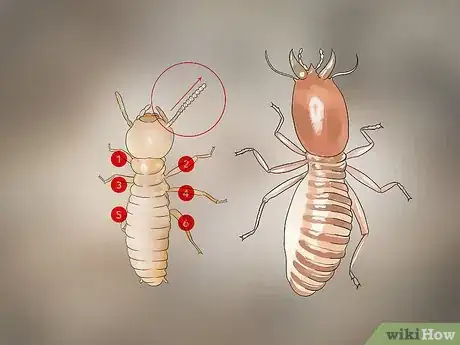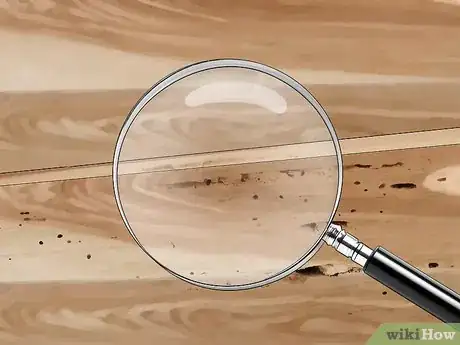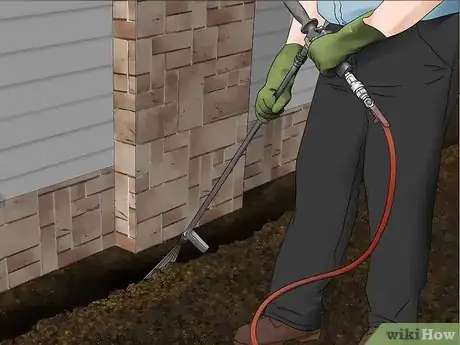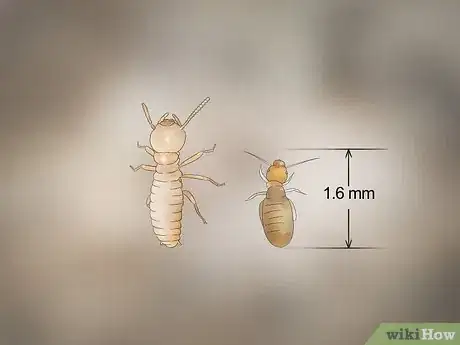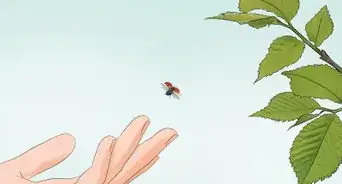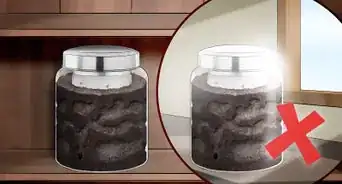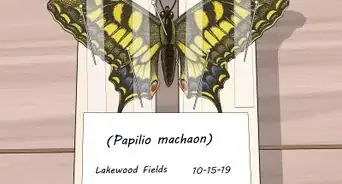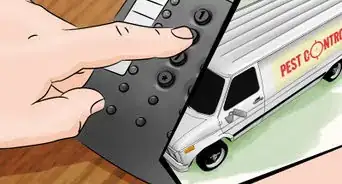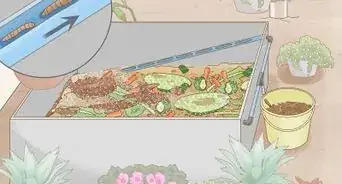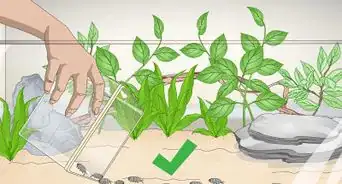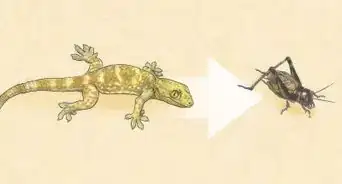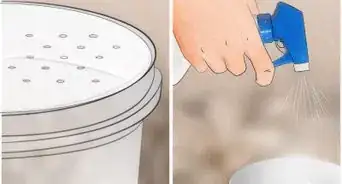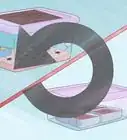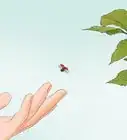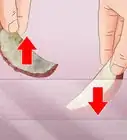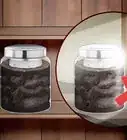This article was co-authored by Joshua Bloom. Joshua Bloom is a Pest Control Specialist and the Vice President of Operations of Standard Pest Management, a pest control company based in New York City. He has over 20 years of experience in the pest control industry and specializes in commercial and large facility pest control management. Standard Pest Control also specializes in ant, bed bug, cockroach, fly, and rodent control. Joshua is licensed by the NYSDEC (New York State Department of Environmental Conservation) for termite control.
There are 11 references cited in this article, which can be found at the bottom of the page.
This article has been viewed 129,454 times.
Termites can pose a serious risk to the structure and foundation of your home. The presence of termite larvae in particular may indicate if the building is infested or not. Termite larvae can be identified by their shape, color, and size. They are often found with worker termites deep within termite colonies. That said, they can mistaken for other insects, so it is important to understand the features and qualities of this particular pest.
Steps
Examining the Termite
-
1Inspect their shape. Larvae have soft bodies instead of a hard, outer shell. They have a distinct head from the rest of their body as well as six legs. Their antennae are straight.[1]
- Termite larvae tend to look extremely similar to worker and nymph termites, except for their size. Larvae are much smaller than workers and nymphs.
- Termites may resemble ants, but where ants’ bodies have a narrow waist, termites’ bodies are smooth and straight. Termites also have straight antennae where ants have bent antennae.[2]
-
2Examine their color. Termite larvae tend to be white and almost translucent in their color. Keep in mind that older worker and nymph termites also have similar pale coloring, so color alone cannot determine if it is a larva or not.
- If they have pale, white bodies but darker heads, they may be soldier termites. These are adult termites.
- If they have a darker color, such as brown or black, they may be booklice or ants instead. If they have wings, they may be reproductive termites.
Advertisement -
3Measure them. Most termite larvae are less than 1/10 of an inch (2.5 mm) long. In comparison, an adult worker termite is usually around ¼ inch (6.4 mm) long. Some reproductive termites, known as alates, can grow to be half an inch (13 mm) large, but if the insect is larger than this, they may not be a termite at all.
- Termite larvae are about the same size as the eggs they emerge from. These eggs are very small and white. They may be difficult to find, as they are kept deep within the colony. That said, if you find some termites near a pile of eggs, you can compare the size. If they’re roughly the same size, you’ve found larvae.[3]
Checking for Termite Larvae
-
1Identify adult termites. If you find mature termites, there are probably larvae somewhere in the colony. While there are a few different types of adult termite, you can typically identify them by their pale, soft bodies. Worker and nymph termites look like larger versions of the larvae while soldiers have a dark, hardened head. Only the reproductive termites that lay eggs have wings.
-
2Inspect areas where termites live. While you may need a professional exterminator to find most termites, you can do a basic check inspection to see if you can notice any signs of infestation. Start by inspecting window sills, window and door frames, support beams, and places where concrete structures join wooden ones.[4] Use a flashlight to peer into cracks and dark spaces.
- You should also check in the basement, in crawl spaces, under the porch, and anywhere that moisture is present.[5]
- Note that termites often live deep within the walls, and they can infest a home for years without being noticed. Just because there are no external signs of termites does not mean that you do not have them.
-
3Listen to the walls. Using a screwdriver, gently tap the wood or surface of a wall. Listen for any hollow or rustling noises coming from inside the wood. This may indicate that there is something living inside the wood.[6]
-
4Break open mud tubes. Termites may build mud tubes to travel between areas of their colony. These may look like branches or lines of mud crawling up the wall or foundation. You can break a tube open to see if there are any termites inside. Note that if a tube is empty, it may still mean that there are termites elsewhere in the building.[7]
-
5Hire an exterminator. Termites can live deep within a structure, and they often keep their larvae within the most protected parts of their nest. To measure the extent of the problem, you should consult with a professional pest control company. They will be able to tell you if you have termites or another pest. They can also identify the larvae for you.
- Contract a reputable company and explore a liquid barrier treatment or the installation of termite bait stations. If there are any areas where moisture is building up, they can help you address that as well.[8]
- When in doubt, the best way to know what type of larva or insect is infesting your home is to catch a few in a glass jar. Show them to an exterminator or local pest expert.
Discerning Between Termite Larvae and Other Insects
-
1Compare ants and termite larvae. As adults, termites and ants can be easily confused. That said, the larvae of the two species are very different. If you’re uncertain if you have termites or ants, try to inspect the larvae if you can find them.
- Termite larvae look like a smaller version of the adult worker and nymph termites; they have a separate, segmented head, legs, and antennae.
- Ant larvae look like grubs. They have no legs or eyes, nor do they appear to have a separate, segmented head. They are also covered in tiny hairs.[9]
-
2Learn to identify psocids or booklice. Like termite larvae, psocids (also known as booklice) are small and white. That said, booklice only grow between 1/16 and 1/8 of an inch long (between 1.6 and 3.2 mm). They do not feed on wood; rather, they eat the fungus that grows on wood, books, and other starchy objects in moist environments.[10]
- If you do not have any damage to the wood or other signs of termites, you may have found psocids instead of termite larvae. To be sure, take a few insects in to your local pest control.
- Places where psocids are found include books, newspapers, moldy foods and grains, old wallpaper, cardboard boxes, and other paper products. In comparison, termites are often found in walls, wood piles, stumps, crawl spaces, and other wooden areas.
-
3Determine if wood damage was caused by beetles instead. Termites are not the only insect to feed on wood. Powderpost beetles look distinctively different than termites. They have darker, harder bodies, and some may be covered with fine hairs. Powderpost larvae are white and C-shaped. They have tiny spines along their back.[11]
- The best way to know if you have powderpost beetles or termites is to hire an exterminator. They may be able to identify the pest based on the pattern of damage they leave behind.
-
4Make sure they are not maggots. Maggots are another type of larva, but they grow into flies instead of termites. Like termites, they are white with soft bodies. That said, unlike termite larvae, maggots do not have a distinct head or if they do, it is not visible. They may have legs, but the rest of their body is shaped like a tube.[12]
- Maggots are often found in rotting material, such as old food or decaying plants.
Expert Q&A
Did you know you can get expert answers for this article?
Unlock expert answers by supporting wikiHow
-
QuestionWhere are termites usually found in a building?
 Joshua BloomJoshua Bloom is a Pest Control Specialist and the Vice President of Operations of Standard Pest Management, a pest control company based in New York City. He has over 20 years of experience in the pest control industry and specializes in commercial and large facility pest control management. Standard Pest Control also specializes in ant, bed bug, cockroach, fly, and rodent control. Joshua is licensed by the NYSDEC (New York State Department of Environmental Conservation) for termite control.
Joshua BloomJoshua Bloom is a Pest Control Specialist and the Vice President of Operations of Standard Pest Management, a pest control company based in New York City. He has over 20 years of experience in the pest control industry and specializes in commercial and large facility pest control management. Standard Pest Control also specializes in ant, bed bug, cockroach, fly, and rodent control. Joshua is licensed by the NYSDEC (New York State Department of Environmental Conservation) for termite control.
Pest Control Specialist
References
- ↑ http://lancaster.unl.edu/pest/termites/pestedpdfchapters2010/tchptr2.pdf
- ↑ https://entomology.ca.uky.edu/ef604
- ↑ http://pests.guru/termites/life-cycle
- ↑ Joshua Bloom. Pest Control Specialist. Personal interview. 8 May 2020.
- ↑ Joshua Bloom. Pest Control Specialist. Personal interview. 8 May 2020.
- ↑ http://owwmedia.com/2015/04/termites-vs-powderpost-beetles/
- ↑ https://entomology.ca.uky.edu/ef604
- ↑ Joshua Bloom. Pest Control Specialist. Personal interview. 8 May 2020.
- ↑ http://antark.net/ant-life/ant-life-cycle/ant-larvae/
About This Article
To identify termite larvae, look for a distinct head and a smooth, straight body with straight antennae. Also, check the color, as termite larvae are usually white and almost translucent. However, look closely, because older worker and nymph termites have a similar color, but their heads will be darker. You can also measure the insect, since termite larvae will typically be less than 1/10 of an inch long, and no more than 1/2 an inch. Keep reading to learn how to tell the difference between termite larvae and ants or booklice!
